Abstract
Since 1977, Vibrio cholerae O1 has been isolated from the Australian aquatic environment and periodically cholera cases have occurred following exposure to these environments. To study the relationships between clinical isolates and environmental isolates from rivers and aquatic life, widely distributed throughout the country, a wide range of molecular typing methods were employed. In this paper we report the analysis of the 180 Australian isolates (10 clinical and 170 environmental) using ribotyping. Seven ribotype patterns were observed among the Australian inaba isolates, 2 of which included all clinical inaba isolates and 84% environmental inaba isolates collected from 9 rivers and creeks in eastern Australia during an 8-year period. Isolates from epidemiologically related clinical cases, asymptomatic household contacts and sewage were indistinguishable. The ogawa isolates were more diverse, with 9 ribotypes observed among 24 isolates from 8 rivers during the same period. Ribotype patterns were not shared between the serotypes with the exception of one ogawa isolate which could be distinguished using PFGE. Ribotyping has been useful in confirming an association between epidemiologically related clinical isolates and the aquatic environment and the persistence of several clones of the O1 serovar in the Australian environment during an 8-year period.
Full text
PDF

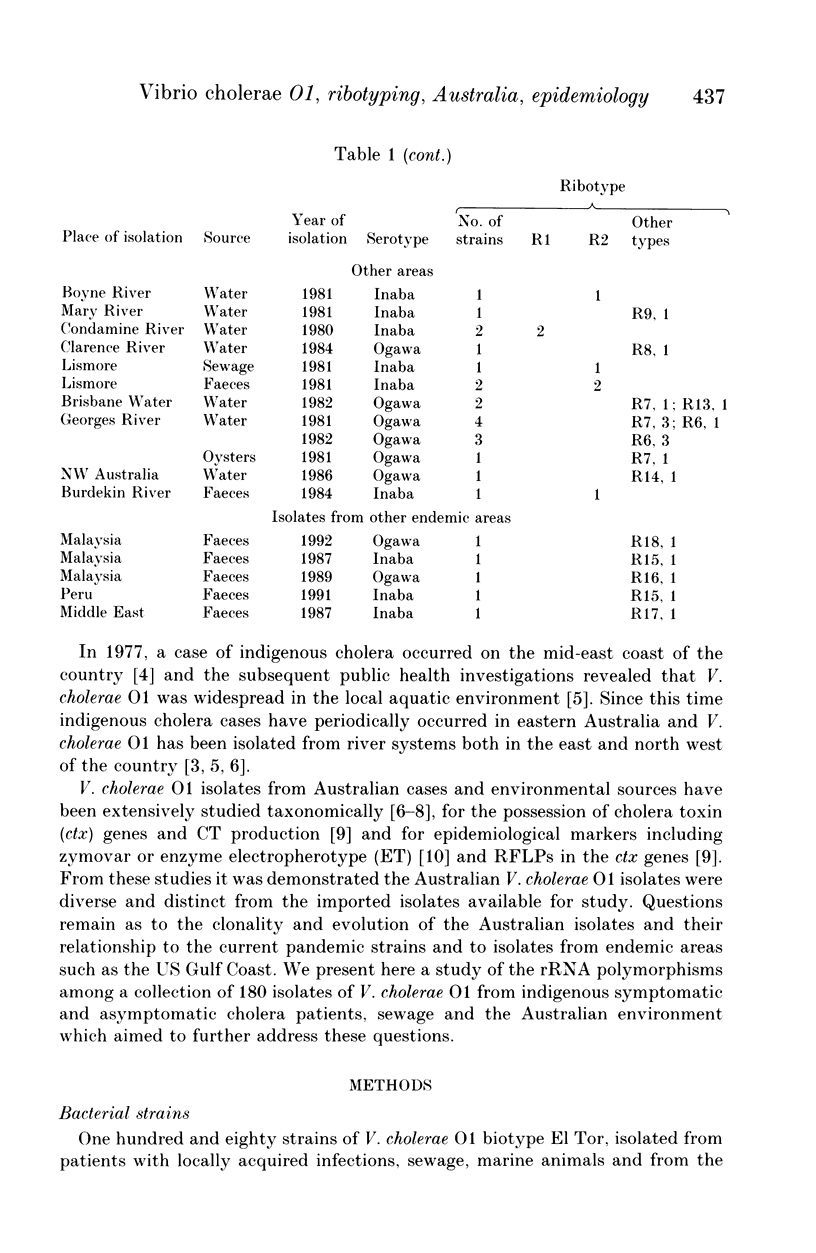

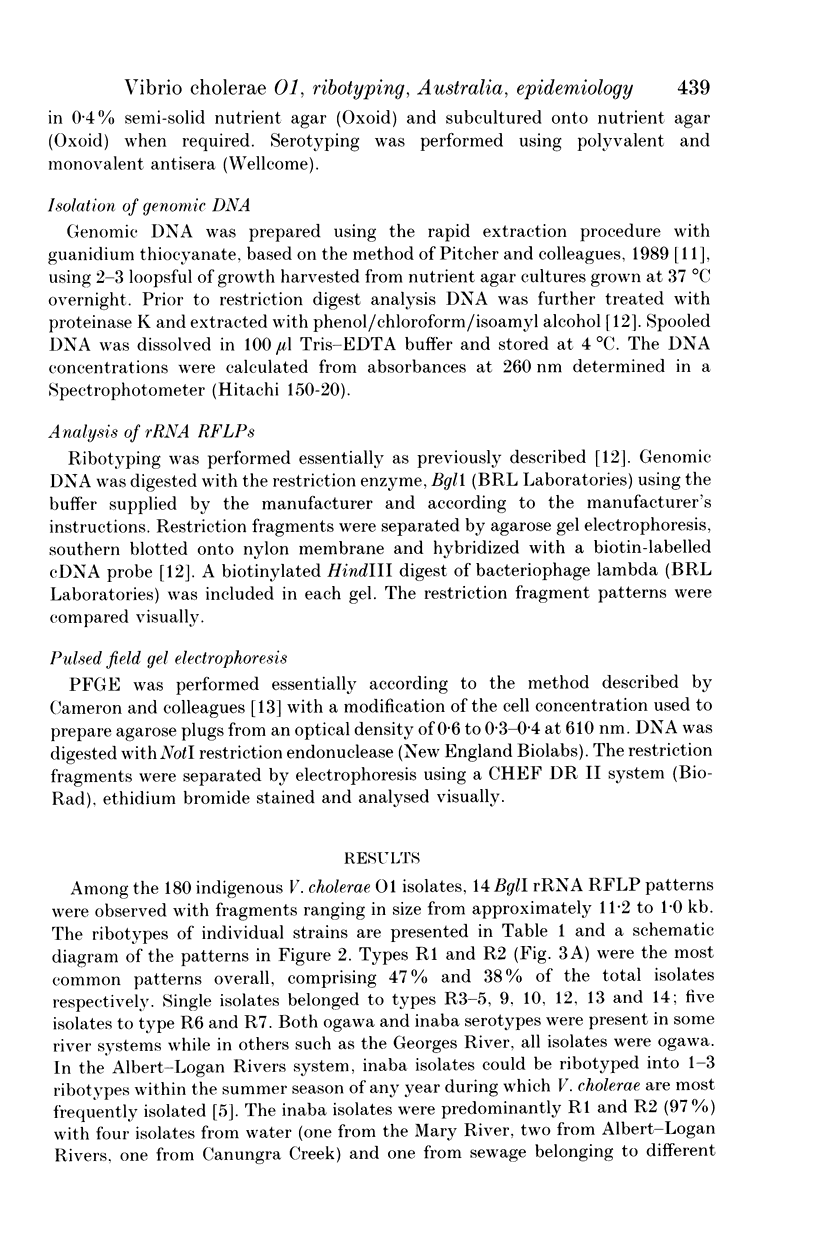
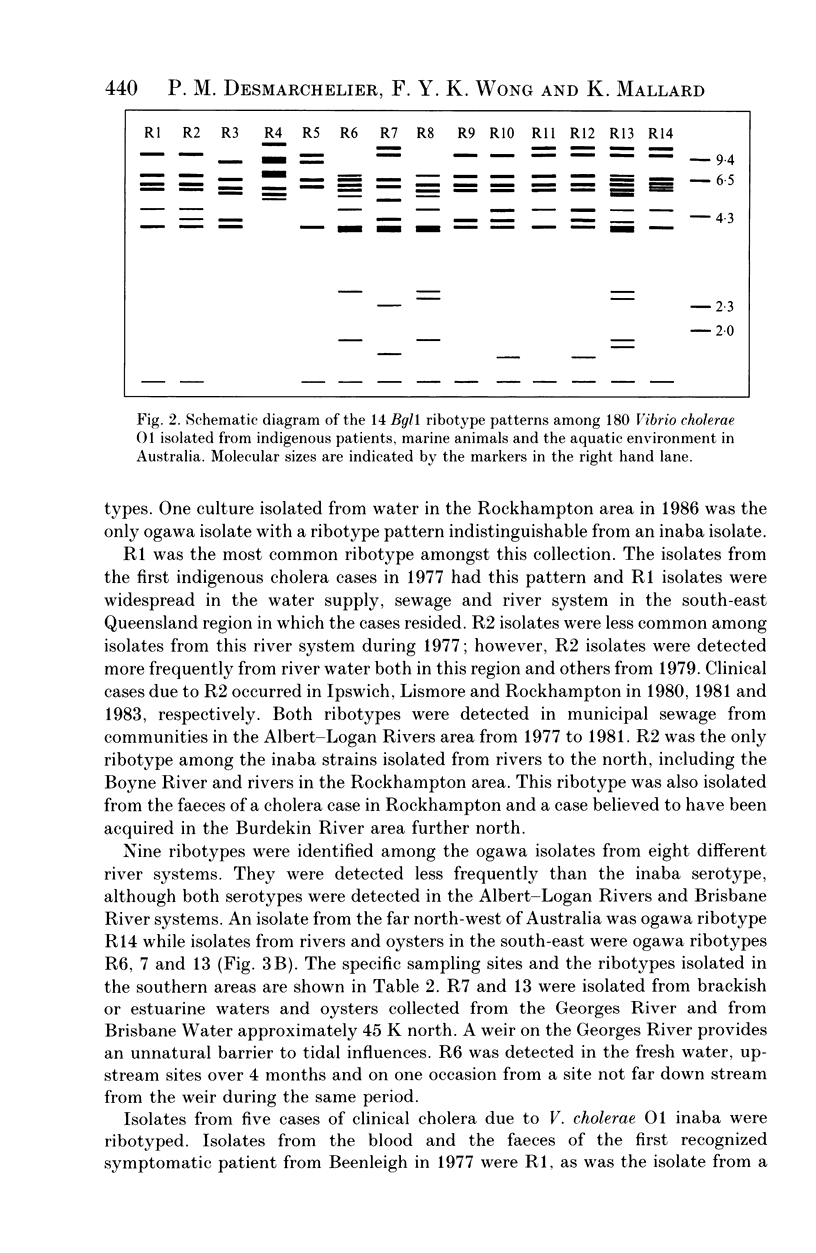
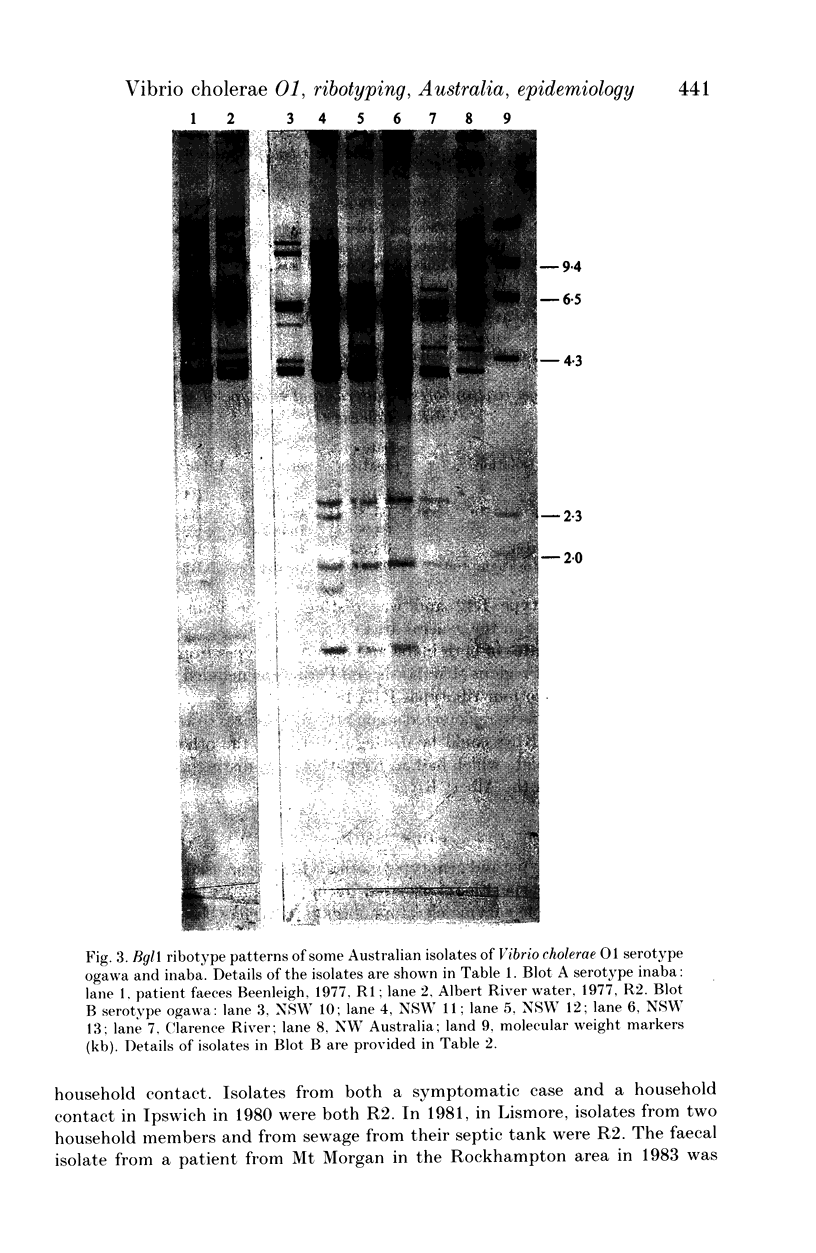




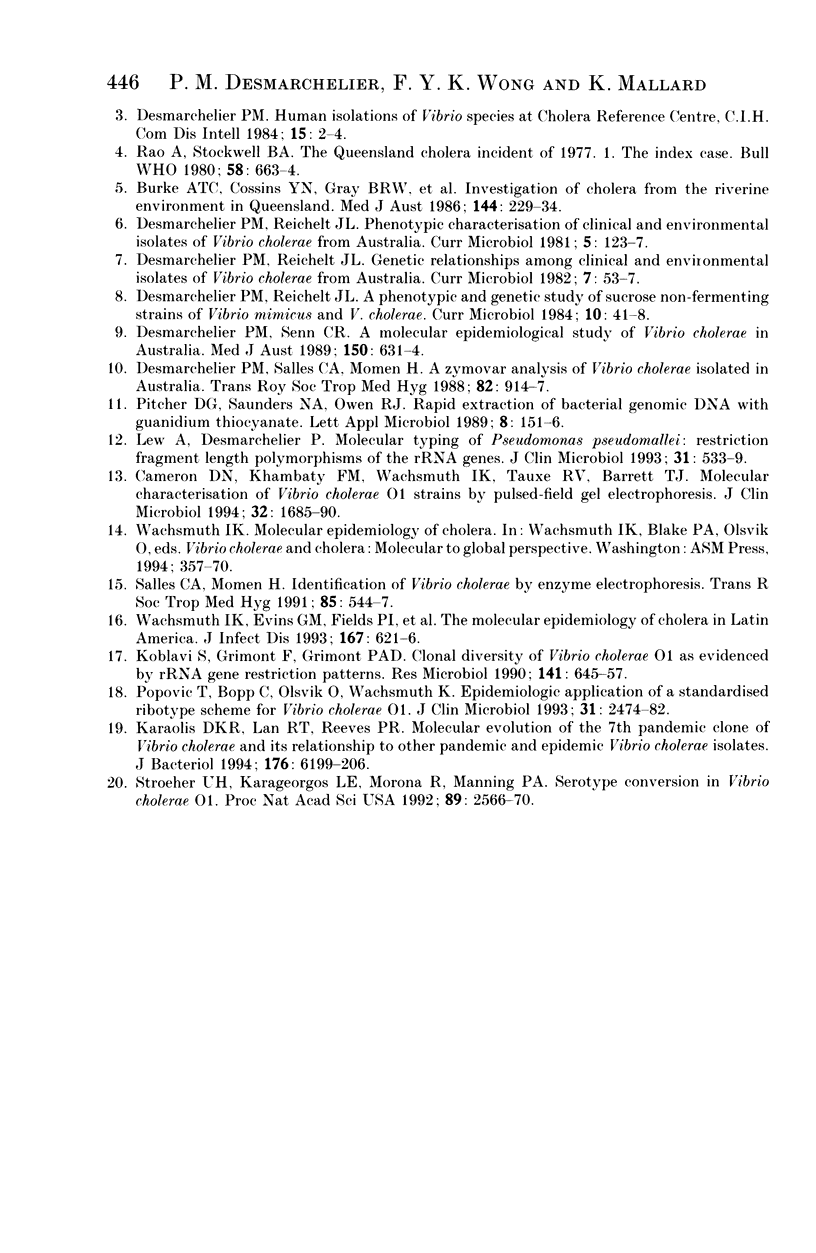
Images in this article
Selected References
These references are in PubMed. This may not be the complete list of references from this article.
- Bourke A. T., Cossins Y. N., Gray B. R., Lunney T. J., Rostron N. A., Holmes R. V., Griggs E. R., Larsen D. J., Kelk V. R. Investigation of cholera acquired from the riverine environment in Queensland. Med J Aust. 1986 Mar 3;144(5):229–234. doi: 10.5694/j.1326-5377.1986.tb115883.x. [DOI] [PubMed] [Google Scholar]
- Cameron D. N., Khambaty F. M., Wachsmuth I. K., Tauxe R. V., Barrett T. J. Molecular characterization of Vibrio cholerae O1 strains by pulsed-field gel electrophoresis. J Clin Microbiol. 1994 Jul;32(7):1685–1690. doi: 10.1128/jcm.32.7.1685-1690.1994. [DOI] [PMC free article] [PubMed] [Google Scholar]
- Desmarchelier P. M., Momen H., Salles C. A. A zymovar analysis of Vibrio cholerae isolated in Australia. Trans R Soc Trop Med Hyg. 1988;82(6):914–917. doi: 10.1016/0035-9203(88)90041-7. [DOI] [PubMed] [Google Scholar]
- Desmarchelier P. M., Senn C. R. A molecular epidemiological study of Vibrio cholerae in Australia. Med J Aust. 1989 Jun 5;150(11):631–634. doi: 10.5694/j.1326-5377.1989.tb136726.x. [DOI] [PubMed] [Google Scholar]
- Karaolis D. K., Lan R., Reeves P. R. Molecular evolution of the seventh-pandemic clone of Vibrio cholerae and its relationship to other pandemic and epidemic V. cholerae isolates. J Bacteriol. 1994 Oct;176(20):6199–6206. doi: 10.1128/jb.176.20.6199-6206.1994. [DOI] [PMC free article] [PubMed] [Google Scholar]
- Koblavi S., Grimont F., Grimont P. A. Clonal diversity of Vibrio cholerae O1 evidenced by rRNA gene restriction patterns. Res Microbiol. 1990 Jul-Aug;141(6):645–657. doi: 10.1016/0923-2508(90)90059-y. [DOI] [PubMed] [Google Scholar]
- Lew A. E., Desmarchelier P. M. Molecular typing of Pseudomonas pseudomallei: restriction fragment length polymorphisms of rRNA genes. J Clin Microbiol. 1993 Mar;31(3):533–539. doi: 10.1128/jcm.31.3.533-539.1993. [DOI] [PMC free article] [PubMed] [Google Scholar]
- Newton-John H. F., Gilbert G. L., Sandland A. M., Yung A. P., Kucers A., Lucas C. R., Bennett N. M., Forbes J. A. Cholera: an imported case in Australia, 1969. Med J Aust. 1971 Jan 16;1(3):135–138. doi: 10.5694/j.1326-5377.1971.tb87474.x. [DOI] [PubMed] [Google Scholar]
- Popovic T., Bopp C., Olsvik O., Wachsmuth K. Epidemiologic application of a standardized ribotype scheme for Vibrio cholerae O1. J Clin Microbiol. 1993 Sep;31(9):2474–2482. doi: 10.1128/jcm.31.9.2474-2482.1993. [DOI] [PMC free article] [PubMed] [Google Scholar]
- Rao A., Stockwell B. A. The Queensland cholera incident of 1977. 1. The index case. Bull World Health Organ. 1980;58(4):663–664. [PMC free article] [PubMed] [Google Scholar]
- Salles C. A., Momen H. Identification of Vibrio cholerae by enzyme electrophoresis. Trans R Soc Trop Med Hyg. 1991 Jul-Aug;85(4):544–547. doi: 10.1016/0035-9203(91)90251-s. [DOI] [PubMed] [Google Scholar]
- Stroeher U. H., Karageorgos L. E., Morona R., Manning P. A. Serotype conversion in Vibrio cholerae O1. Proc Natl Acad Sci U S A. 1992 Apr 1;89(7):2566–2570. doi: 10.1073/pnas.89.7.2566. [DOI] [PMC free article] [PubMed] [Google Scholar]
- Wachsmuth I. K., Evins G. M., Fields P. I., Olsvik O., Popovic T., Bopp C. A., Wells J. G., Carrillo C., Blake P. A. The molecular epidemiology of cholera in Latin America. J Infect Dis. 1993 Mar;167(3):621–626. doi: 10.1093/infdis/167.3.621. [DOI] [PubMed] [Google Scholar]




